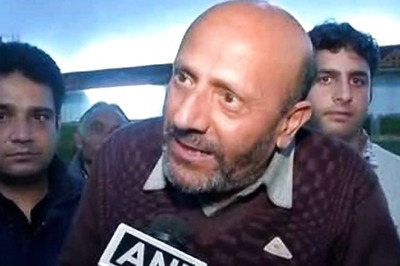
views
The inauguration of the first multi-modal terminal on the Ganga River in Varanasi last month was publicised by the Centre as a major breakthrough in search for cheap mode of transport. It also was feted as major feat for generating employment in Prime Minister Narendra Modi’s parliamentary constituency of Varanasi.
The cargo route is soon to be extended up to Allahabad aka Prayagraj. However, down the stream, the move has not generated much appreciation, as the stretch of river closer to the delta, especially as it flows east of Patna into Jharkhand and West Bengal before joining the Bay of Bengal, is home to the threatened Gangetic Dolphins, which ironically has been christened by the government as the National Aquatic Animal.
The NDA government enacted National Waterways Act, 2016, which declared 111 inland waterways as National Waterways (NWs) in addition to the five existing NWs across 24 states for utilising them as sustainable mode of transport. Of the total 111 inland waterways, 38 are habitat of the riverine dolphins.
So, in achieving the so-called development feat, ecological health of the rivers would stand to be compromised. Moreover, this move goes against the spirit of ‘Namami Gange’, under which the same government is spending millions to bring the river to its pristine glory by making it free from pollution and saving its biodiversity.
The commencement of Jal Marg Vikas Project (JMVP) aims at developing the stretch of the Ganga River between Varanasi and Haldia for navigation of large vessels weighing up to 1,500-2,000 tonnes.
This project includes construction of three multi-modal terminals (Varanasi in Uttar Pradesh, Sahibganj in Jharkhand and Haldia in West Bengal); two inter-modal terminals; five roll on-roll off terminal pairs; a new navigation lock at Farakka; assured depth dredging; integrated vessel repair and maintenance facility, differential global positioning system, river information system, river training and river conservancy works.
But what does this mean for the river, its waters and the creatures that live in it? River experts feel that it is a misnomer to say that inland water transport would be cheap. The most contentious issue is dredging of the river and its costs.
To allow ocean vessels to traverse a river, it should have a depth of 2 to 3 metres and a width of 45-60 metres, parameter that the Ganga River does not fulfil. The river will have to be dredged continuously which will cause severe erosion.
Besides erosion, dredging will destroy aquatic life of the river as dredging increases water turbidity, which affects fish.
It also affects benthic organisms that are creatures which live in and on the bottom of the river bed. They include worms, clams, crabs, lobsters, sponges, and many other tiny organisms that live in the nethermost sediments.
Several conservation groups have now planned a Sadbhavna Yatra from Varanasi to Gangasagar in West Bengal to create awareness about the threat posed by the inland waterways.
“The habitat of these aquatic flora (still to be sufficiently studied) and fauna especially in the sanctuaries will be altered due to dredging, river water pollution due to oil spillage and waste disposal activities which pose real challenges,” says Arvind Mishra, founder of Mandar Nature Club, which works extensively in the Vikramshila Gangetic Dolphin Sanctuary near Bhagalpur.
“Riverine biodiversity concerns like threat to fish, turtles, gavial, otter, molluscs and crustaceans and dolphin and birds have not been considered properly while introducing intense water transport in the Ganga,” says Mishra.
There is also a need to understand that most of the ships on the Ganga River will be carrying cargo of mostly coal and crude oil. Spillage of these substances could cause irrevocable damage to the ecosystem of river.
Union ministry of environment, forest and climate change had recently commissioned a research project to study about effects of transporting coal between Farakka and Haldia as thermal power plant at Farakka regularly needs coal and ships travel upriver from Haldia. The study revealed that coal transportation had severely affected fish stocks.
Big ships passing through the river would also cause lots of noise affecting fish and other wildlife mostly the Gangetic dolphin. This is common knowledge that river dolphins find their way through echolocation. Noise generated by these vessels would disturb their delicate Sound Navigation and Ranging (SONAR) and affect them in such a way that cannot be assessed.
JMVP also plans construction of barrages and locks on the Ganga, which might reduce river flow at various stretches making things difficult for wildlife.
Gharial is another species that would be affected by this new venture as for Ganga is home for the fish-eating crocodile. Though Varanasi-Haldia stretch has a negligible population of gharials, Ganga tributaries like Yamuna, the Gandak and Ghagra have lots of them. The government has declared Gandak River to be the National Waterway 37.
Big vessels could disturb gharials, dredging would destroy mid-channel sand islands, vital to the animal for basking and regulating its body temperature. In case ships start plying the Gandak, it will be catastrophic for the gharial as scientists have already warned. Incidentally Varanasi itself is home to the famous turtle sanctuary.
Those supporting the inland waterways point towards their use in big global rivers like the Amazon, Yangtze and Mississippi that are regularly traversed by vessels. Even smaller rivers like the Clyde and Thames in the UK and the Elbe in Germany have ocean-going vessels plying in them.
The difference is that unlike them the Indian rivers are Monsoon-fed and do not have voluminous discharge of their own as these rivers. Moreover, high levels of water for navigation in Ganga and other Indian rivers are available only during the Monsoon months.
(The writer is a senior journalist. Views expressed are personal)



















Comments
0 comment